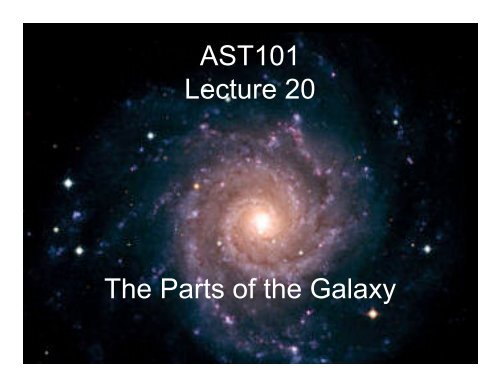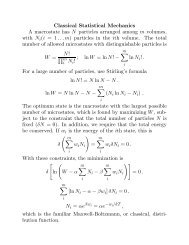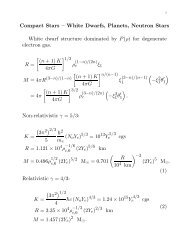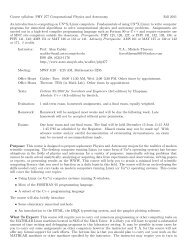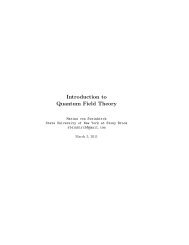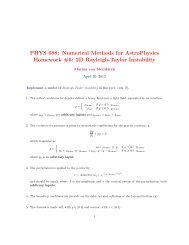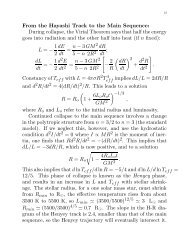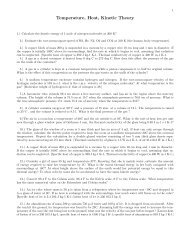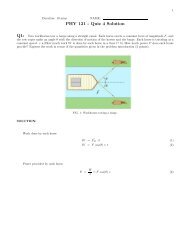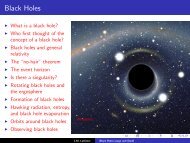AST101 Lecture 20 The Parts of the Galaxy
AST101 Lecture 20 The Parts of the Galaxy
AST101 Lecture 20 The Parts of the Galaxy
Create successful ePaper yourself
Turn your PDF publications into a flip-book with our unique Google optimized e-Paper software.
<strong>AST101</strong><br />
<strong>Lecture</strong> <strong>20</strong><br />
<strong>The</strong> <strong>Parts</strong> <strong>of</strong> <strong>the</strong> <strong>Galaxy</strong>
Shape <strong>of</strong> <strong>the</strong> <strong>Galaxy</strong>
Constituents <strong>of</strong> <strong>the</strong> <strong>Galaxy</strong><br />
~4 x 10 11 stars (90% <strong>of</strong> <strong>the</strong> visible mass)<br />
• Disk population (population I)<br />
– Younger stars<br />
– Higher metallicity<br />
– Orbits in plane <strong>of</strong> <strong>Galaxy</strong><br />
• Spheroidal population (population II)<br />
– Older stars<br />
– Lower metallicity<br />
– Randomly-directed orbits<br />
– Globular Clusters
Globular<br />
Cluster<br />
• About 10 10 years<br />
old<br />
• 10 5 - 10 6 stars<br />
• Radius ~ 10 light<br />
years<br />
• Most massive<br />
star:<br />
~ 1 solar mass<br />
• ~150 globular<br />
clusters known<br />
in Milky Way
Age and Location<br />
• <strong>The</strong> oldest population is <strong>the</strong> halo<br />
(including <strong>the</strong> globular clusters)<br />
• <strong>The</strong> bulge is also old<br />
• <strong>The</strong> disk is youngest<br />
<strong>The</strong> age is correlated with flatness<br />
<strong>The</strong> Sun is in <strong>the</strong> disk
Constituents <strong>of</strong> <strong>the</strong> <strong>Galaxy</strong><br />
Gas and dust (10% <strong>of</strong> <strong>the</strong> visible mass)<br />
• Interstellar medium:<br />
– Warm 10 4 K to hot 10 6 K<br />
– Low density: 0.01 - 1 H/cm 3<br />
• Molecular clouds:<br />
– Cold:
Barnard<br />
163<br />
dark cloud
Evidence for <strong>the</strong> ISM<br />
• We see absorption by dark clouds<br />
• We see absorption lines in <strong>the</strong> spectra <strong>of</strong><br />
stars<br />
• We see emission from Hydrogen<br />
• Distant stars are fainter and redder than<br />
expected<br />
<strong>The</strong> ISM attenuates starlight by about 1<br />
magnitude every 3000 light years
Reddening Illustrated
Red, Reddening, Redshifted<br />
• Red: a color. Red stars are cooler than blue<br />
stars (remember <strong>the</strong> blackbody)<br />
• Reddening: <strong>the</strong> effect <strong>of</strong> interstellar<br />
absorption. Dust absorbs/scatters blue light more than red<br />
light. <strong>The</strong> reason <strong>the</strong> sky is blue.<br />
• Redshift: Doppler shift from a source moving<br />
away
<strong>The</strong> Neighborhood
Charting <strong>the</strong> <strong>Galaxy</strong>
Gas and Dust in <strong>the</strong> IR
Hydrogen in <strong>the</strong> Galactic Plane
<strong>The</strong> 21 cm line <strong>of</strong> Hydrogen<br />
• Hydrogen is<br />
abundant (90%<br />
<strong>of</strong> all atoms)<br />
• Radio waves<br />
penetrate gas<br />
and dust<br />
• Velocities let us<br />
map out<br />
location <strong>of</strong> H in<br />
<strong>the</strong> <strong>Galaxy</strong>
Spiral<br />
Arms<br />
An<br />
effervescent<br />
phenomenon
Spiral Density Waves
Spiral Arms<br />
Marked by:<br />
• Pileup <strong>of</strong> gas and dust<br />
• Star formation due to increased<br />
densities<br />
• Bright young stars<br />
Inter-arm regions: uniform density <strong>of</strong> stars
Meet <strong>the</strong> Neighbors
Large Magellanic Cloud
How <strong>the</strong> Milky Way Was Built<br />
<strong>The</strong><br />
Sagittarius<br />
Dwarf <strong>Galaxy</strong>
Orbit <strong>of</strong> <strong>the</strong> Sgr Dwarf <strong>Galaxy</strong>
Galactic Cannibalism


